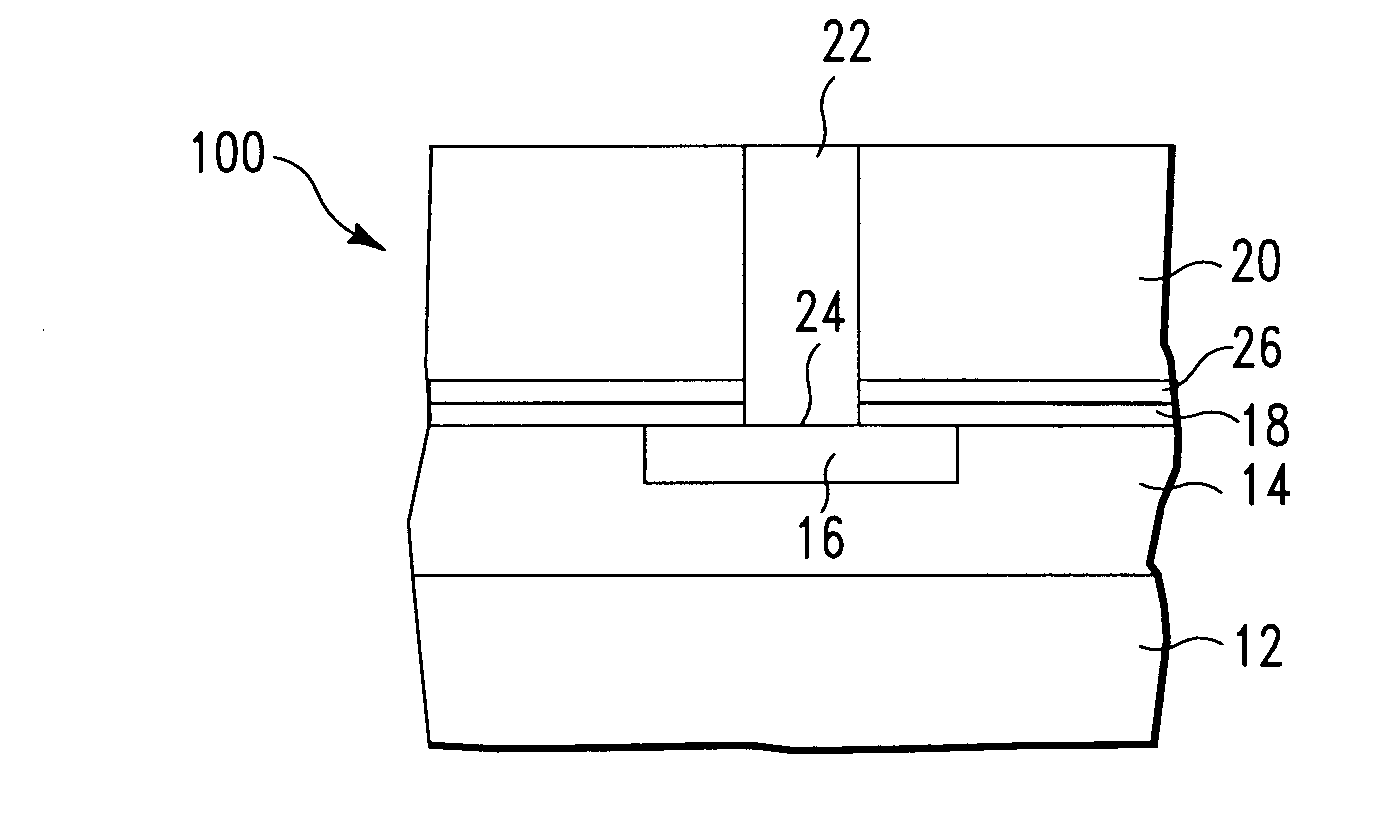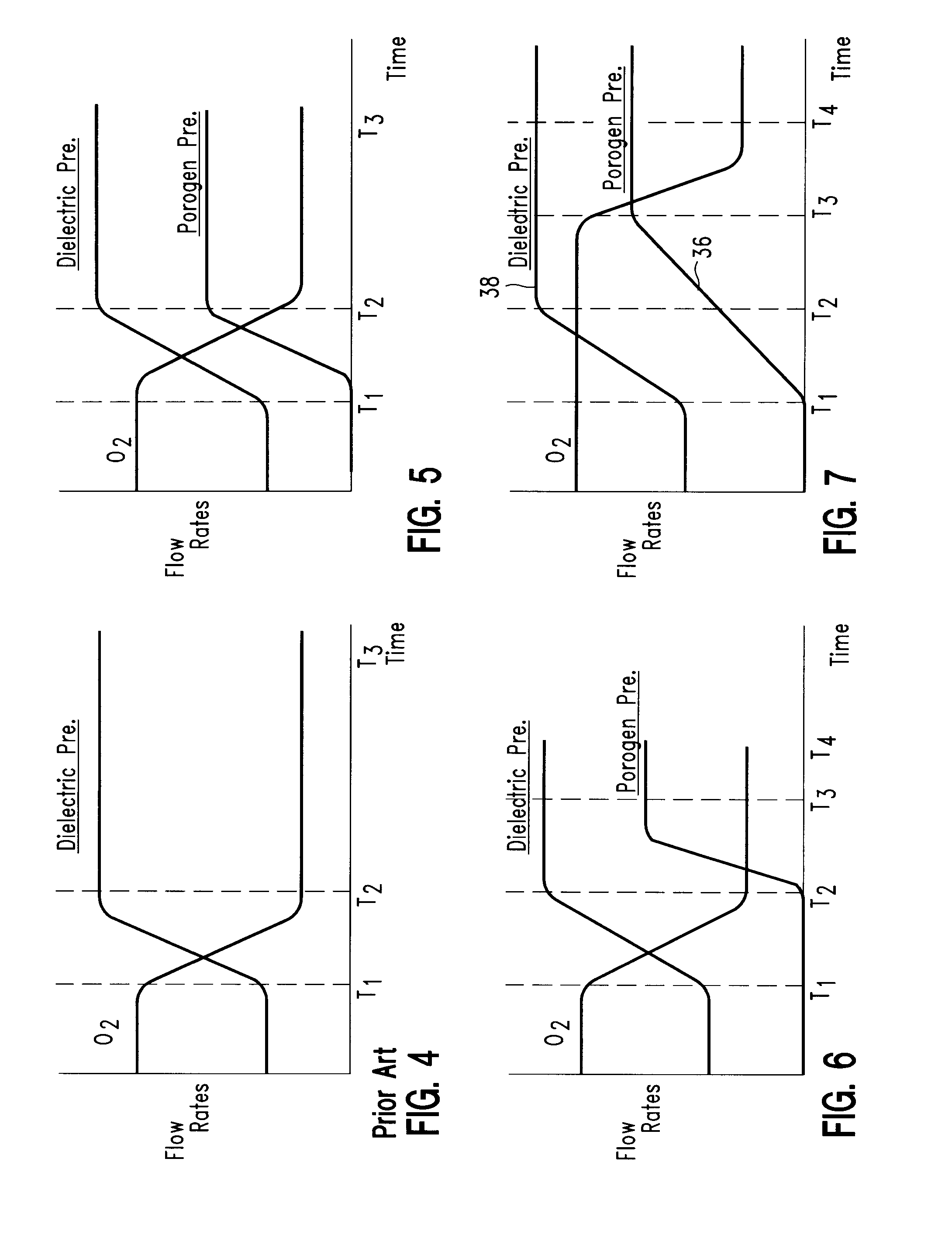STRUCTURE AND METHOD FOR SiCOH INTERFACES WITH INCREASED MECHANICAL STRENGTH
a technology of mechanical strength and structure, applied in the direction of resistive material coating, solid-state device, chemical vapor deposition coating, etc., can solve the problems of reducing the reliability of mechanical response, dicing into chips, and increasing signal delays in ulsi electronic devices, so as to improve the interfacial strength between different layers
- Summary
- Abstract
- Description
- Claims
- Application Information
AI Technical Summary
Benefits of technology
Problems solved by technology
Method used
Image
Examples
example 1
[0071]A Si wafer containing a layer of SiCNH alloy was used to simulate an interconnect substrate with the same SiCNH alloy capping a pre-formed patterned interconnect layer. A Si wafer containing a layer of SiCNH alloy was placed in a PECVD chamber and a porous SiCOH layer was prepared according to the flow rates of oxygen, dielectric precursor and porogen precursor illustrated in FIG. 5. Particulars of the process are described in the following Table 1.
TABLE 1Step Label in Figure0 to T1T1 to T2T3Duration (seconds)1 to 41 to 430 to 60RF Power, GeneralLowHighHighDescriptionExample RF Power (W)300–500600–700600–700Dielectric Precursor FlowLowRamping Low toHighHighPorogen precursor FlowZeroRamping to HighHighO2 FlowHighLowLow
[0072]A TOF-SIMS analysis was done of the completed structure. The result is illustrated in FIG. 9.
[0073]The X axis of FIG. 9 is the sputter time, which is proportional to depth into the sample with zero of the X axis being the top surface of the sample and the ti...
example 2
[0075]A second Si wafer containing a layer of SiCNH alloy (simulating an interconnect substrate) was placed in a PECVD chamber and a porous SiCOH formed according to the flow rate profiles of oxygen, DEMS dielectric precursor and BCHD porogen precursor as illustrated in FIG. 6. The particulars of the process are illustrated in Table 2 below.
TABLE 2Step Label in Figure0 to T1T1 to T2T2 to T3T4Duration (seconds)1 to 41 to 41 to 430 to 60RF Power, GeneralLowHighHighHighDescriptionExample RF Power (W)300–500600–700600–700600–700Dielectric PrecursorLowRampingHighHighFlowLow toHighPorogen precursor FlowZeroZeroRampingHighto HighO2 FlowHighLowLowLow
[0076]It was found advantageous by the inventors to decrease the power density of the plasma such that steps 0 to T2 are performed with a reduced power density and steps after T2 are performed with a higher power density. It was found advantageous by the inventors that a SiCOH precursor ramp rate between 500 to 1500 milligrams per minute / second ...
example 3
[0078]A third interconnect substrate was prepared by placing the substrate in a PECVD chamber and flowing oxygen, DEMS dielectric precursor and BCHD porogen precursor according to the flow rate profile illustrate in FIG. 7. The particulars of the process are illustrated in Table 3 below.
TABLE 3Step Label in Figure0 to T1T1 to T2T2 to T3T4Duration (seconds)1 to 41 to 4430 to 60RF Power, GeneralLowHighHighHighDescriptionExample RF Power (W)300–500600–700600–700600–700Dielectric Precursor FlowLowRampingHighHighLow toHighPorogen precursor FlowZeroRampingRampingHighto Highto HighO2 FlowHighHighHighLow
[0079]It was found advantageous by the inventors to decrease the power density of the plasma such that steps 0 to T2 are performed with a reduced power density and steps after T2 are performed with a higher power density. It was found advantageous by the inventors that a SiCOH precursor ramp rate between 500 to 1500 milligrams per minute / second and a porogen precursor ramp rate between 100 t...
PUM
| Property | Measurement | Unit |
|---|---|---|
| dielectric constant | aaaaa | aaaaa |
| dielectric constant | aaaaa | aaaaa |
| thickness | aaaaa | aaaaa |
Abstract
Description
Claims
Application Information
 Login to View More
Login to View More - R&D
- Intellectual Property
- Life Sciences
- Materials
- Tech Scout
- Unparalleled Data Quality
- Higher Quality Content
- 60% Fewer Hallucinations
Browse by: Latest US Patents, China's latest patents, Technical Efficacy Thesaurus, Application Domain, Technology Topic, Popular Technical Reports.
© 2025 PatSnap. All rights reserved.Legal|Privacy policy|Modern Slavery Act Transparency Statement|Sitemap|About US| Contact US: help@patsnap.com



